Discover 35 hidden attractions, cool sights, and unusual things to do in Saint Paul (United States). Don't miss out on these must-see attractions: Twin City Model Railroad Museum, James J. Hill House, and Cathedral of Saint Paul. Also, be sure to include Fort Snelling in your itinerary.
Below, you can find the list of the most amazing places you should visit in Saint Paul (Minnesota).
Table of Contents
Twin City Model Railroad Museum
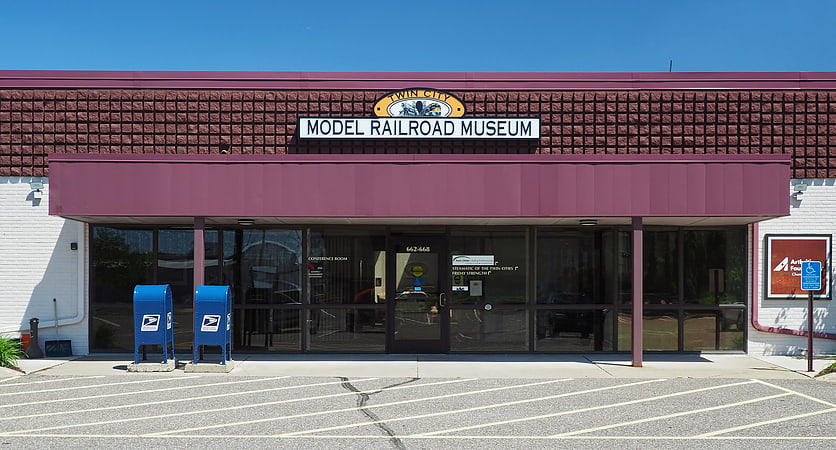
Museum in Saint Paul, Minnesota. The Twin City Model Railroad Museum is a railroad museum in Saint Paul, Minnesota, United States, which has a large display of model railroads. The museum has had a home in Saint Paul since 1934, where it first started as a club. In later years the museum established a home in the Saint Paul Union Depot, and later in Bandana Square. On October 16, 2015, the museum announced that it was looking for a new home. The museum subsequently announced it would be moving to a new location in spring of 2016. The museum reopened on May 17, 2016, in their new location at 668 Transfer Road, Suite 8. The new location is just south of the former Amtrak Midway Depot along the Minnesota Commercial railyard.[1]
Address: 668 Transfer Rd, 55114-1431 Saint Paul
James J. Hill House
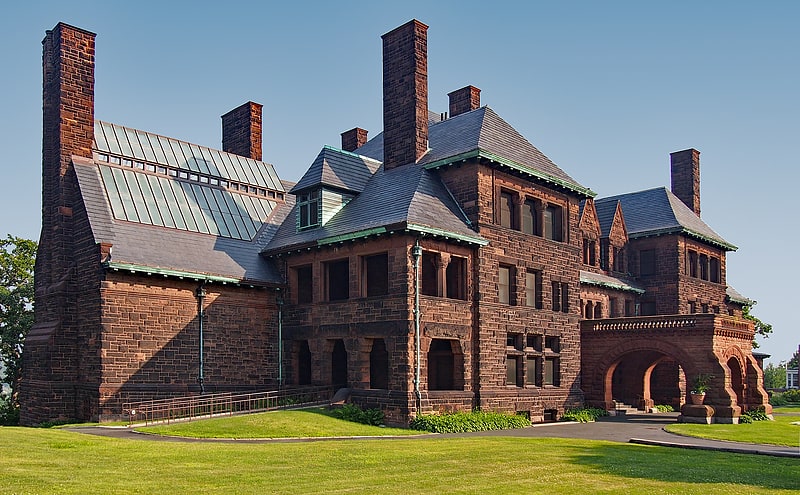
History museum in Saint Paul, Minnesota. The James J. Hill House in Saint Paul, Minnesota, United States, was built by railroad magnate James J. Hill. The house, completed in 1891, is near the eastern end of Summit Avenue near the Cathedral of Saint Paul. The house, for its time, was very large and was the "showcase of St. Paul" until James J. Hill's death in 1916. It is listed as a U.S. National Historic Landmark, operated by the Minnesota Historical Society. It is also a contributing property to the Historic Hill District.
The home has 36,000 square feet (3,344 square meters) of living area and 44,552 square feet of total space.[2]
Address: 240 Summit Ave, 55102-2194 Saint Paul
Cathedral of Saint Paul
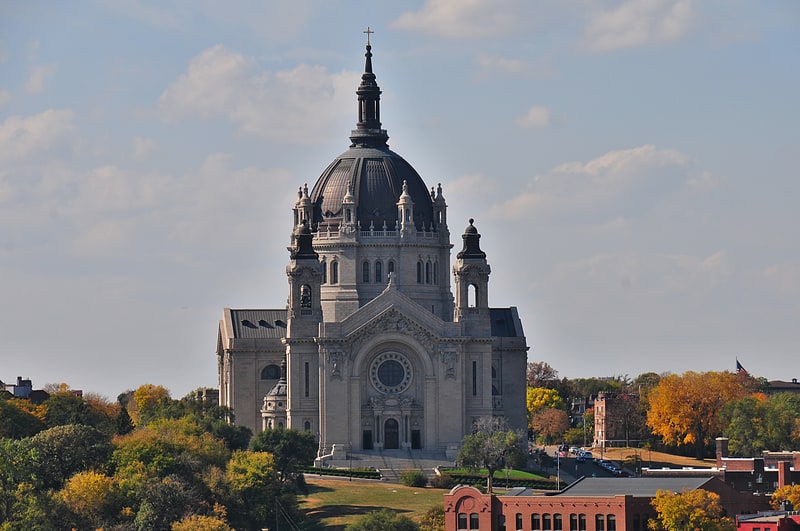
Revered beaux arts landmark from 1915. The Cathedral of Saint Paul is a Roman Catholic cathedral in the city of St. Paul, Minnesota. It is the Cathedral of the Archdiocese of Saint Paul and Minneapolis; the Co-Cathedral is the Basilica of St. Mary in Minneapolis. One of the most distinctive cathedrals in the United States, it sits on Cathedral Hill overlooking downtown St. Paul and features a distinctive copper-clad dome. It is dedicated to Paul the Apostle, who is also the namesake of the City of St. Paul. The current building opened in 1915 as the fourth cathedral of the archdiocese to bear this name. On March 25, 2009, it was designated as the National Shrine of the Apostle Paul by the United States Conference of Catholic Bishops and the Vatican. It is the third-largest Catholic cathedral and sixth-largest church in the United States.[3]
Address: 239 Selby Ave, 55102 St Paul
Fort Snelling
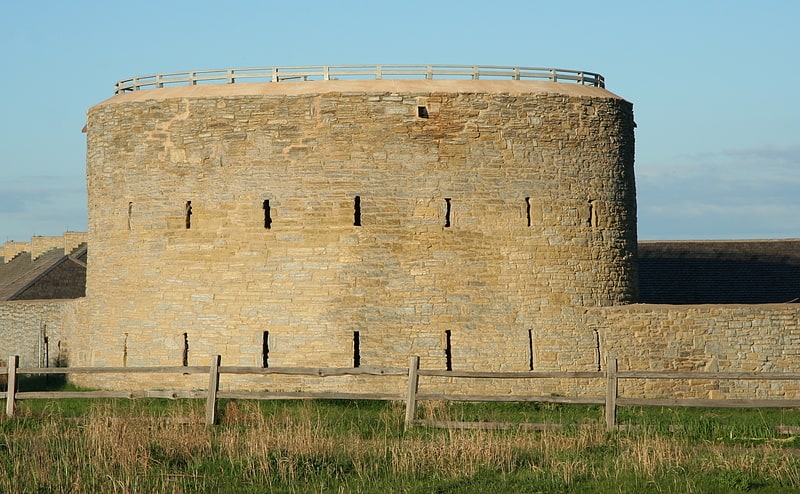
Historical landmark in Hennepin County, Minnesota. Fort Snelling is a former military fortification and National Historic Landmark in the U.S. state of Minnesota on the bluffs overlooking the confluence of the Minnesota and Mississippi Rivers. The military site was initially named Fort Saint Anthony, but it was renamed Fort Snelling once its construction was completed in 1825.
The U.S. Army supported slavery at the fort by allowing its soldiers to bring their personal enslaved people. These included African Americans, Dred Scott and Harriet Robinson Scott who lived at the fort in the 1830s as enslaved people. In the 1840s the Scotts sued for their freedom, arguing that having lived in “free territory” made them free leading to the landmark case Dred Scott v. Sandford. Slavery ended at the fort just before Minnesota statehood in 1858.
The fort served as the primary center for Government forces during the Dakota War of 1862. It also was the site of the encampment where the eastern Dakota and Ho-chunk non-combatants awaited riverboat transport in their forced removal from Minnesota when the hostilities ceased. The fort served as a recruiting station for the Civil War, Spanish American War, and both World Wars before being decommissioned a second time in 1946. It then fell into a state of disrepair until the lower post was restored to its original appearance in 1965. At that time all that remained of the original lower post were the round and hexagon towers. Many of the important buildings of the upper post remain today with some still in disrepair.
The historic fort is in the unorganized territory of Fort Snelling within Hennepin County, bordering Ramsey and Dakota counties.
There are now multiple government agencies that own portions of the former fort with the Minnesota Historical Society administering the Historic Fort Snelling site. The Minnesota Department of Natural Resources administers Fort Snelling State Park at the bottom of the bluff. Fort Snelling once encompassed the park's land. It has been cited as a "National Treasure" by the National Trust for Historic Preservation. The historic fort is in the Mississippi National River and Recreation Area, a National Park Service unit.[4]
Address: 200 Tower Ave, 55111-4037 Saint Paul
Science Museum of Minnesota
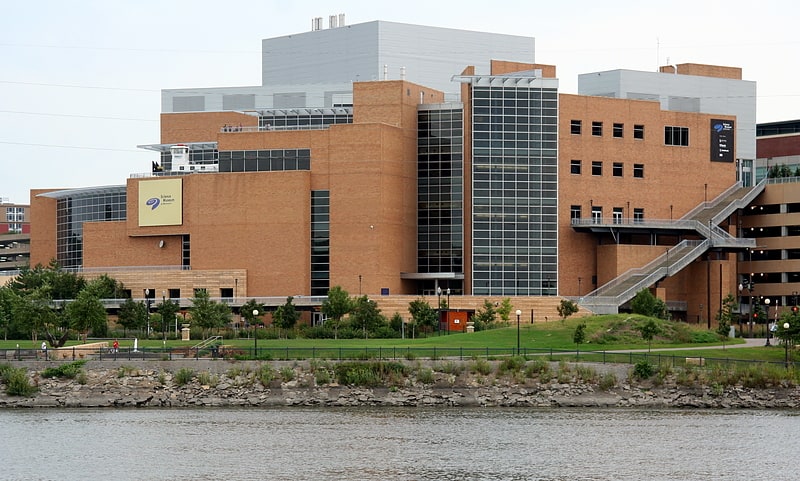
Interactive exhibits and educational films. Science Museum of Minnesota is an American museum focused on topics in technology, natural history, physical science, and mathematics education. Founded in 1907 and located in Saint Paul, Minnesota, the 501 nonprofit institution is staffed by over 300 employees and is supported by hundreds of volunteers. The museum seeks to deliver science and education that centers equity, and its mission statement is to "Turn on the science: Inspire learning. Inform policy. Improve lives."[5]
Address: 120 W Kellogg Blvd, 55102 St Paul
Harriet Island Regional Park

Building. The Harriet Island Pavilion, also known as the Clarence W. Wigington Pavilion, is a park pavilion on Harriet Island just across the Mississippi River from downtown Saint Paul, Minnesota, United States. It was designed by Clarence W. Wigington, the nation's first black municipal architect, and renamed for Wigington after a 2000 restoration. Harriet island was named for Harriet Bishop, a Baptist school teacher from Vermont. She arrived in Saint Paul in 1847, was involved in the temperance movement, and opened the first school in the frontier city, teaching children of diverse ethnic, racial, and religious backgrounds.[6]
Address: 200 Dr Justice Ohage Blvd, 55107 Saint Paul (West Side)
Xcel Energy Center
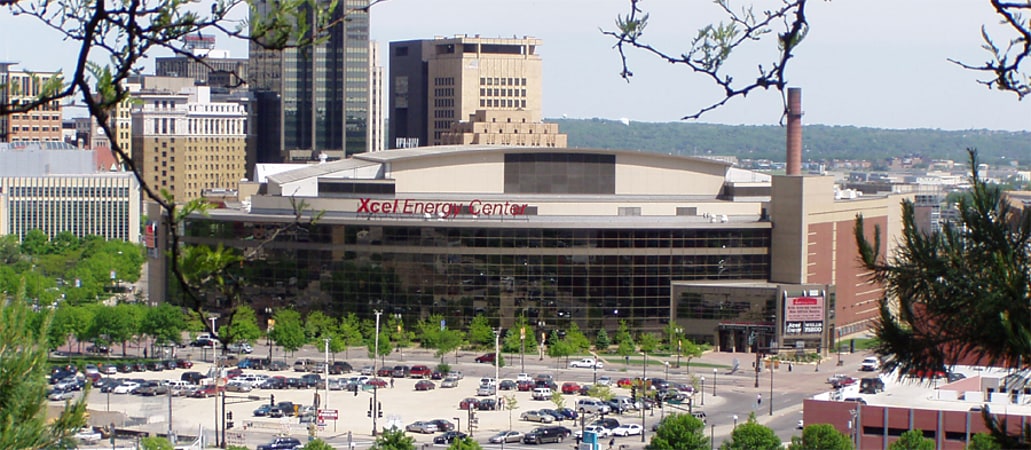
Arena in Saint Paul, Minnesota. Xcel Energy Center is a multipurpose arena in Saint Paul, Minnesota, United States. Completed in 2000, it is named for its locally based corporate sponsor Xcel Energy. With an official capacity of 17,954, the arena has four spectator levels: one suite level and three for general seating. The building is home to the NHL's Minnesota Wild.
The arena is owned by the city of Saint Paul and operated by the Wild's parent company, Minnesota Sports & Entertainment. It is on the same block as the RiverCentre convention facility, Roy Wilkins Auditorium and the Ordway Center for the Performing Arts, in downtown St. Paul, and shares a single indoor access area with RiverCentre and Roy Wilkins Auditorium. It also hosted the 2008 Republican National Convention.[7]
Address: Saint Paul, 199 Kellogg Boulevard West
Como Town
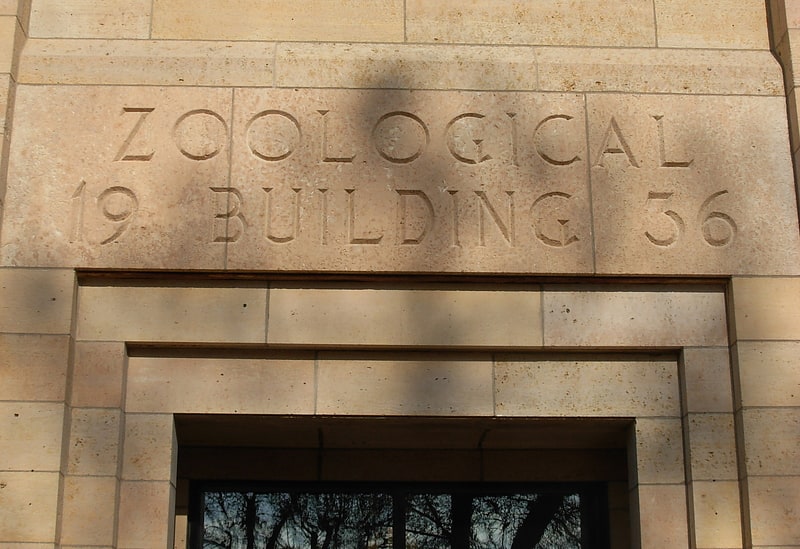
Scenic place with a lake, zoo and gardens. Como Zoo was the first zoo established in Minnesota. Founded in 1897, the zoo is located within Como Park, in Saint Paul, Minnesota. Como Zoo is a member of the Association of Zoos and Aquariums.[8]
Address: 1301 Midway Pkwy, 55103 Saint Paul (Como Park)
Minnesota Children's Museum

Non-profit. The Minnesota Children's Museum is a children's museum in Saint Paul, Minnesota. Founded in 1981 in Minneapolis, the museum moved to St. Paul in 1995.
The museum includes natural exhibits of Minnesota, developmental learning areas for small children, a creativity and problem- solving area, and national traveling exhibits.[9]
Address: 10 7th St W, 55102 St Paul
Marjorie McNeely Conservatory
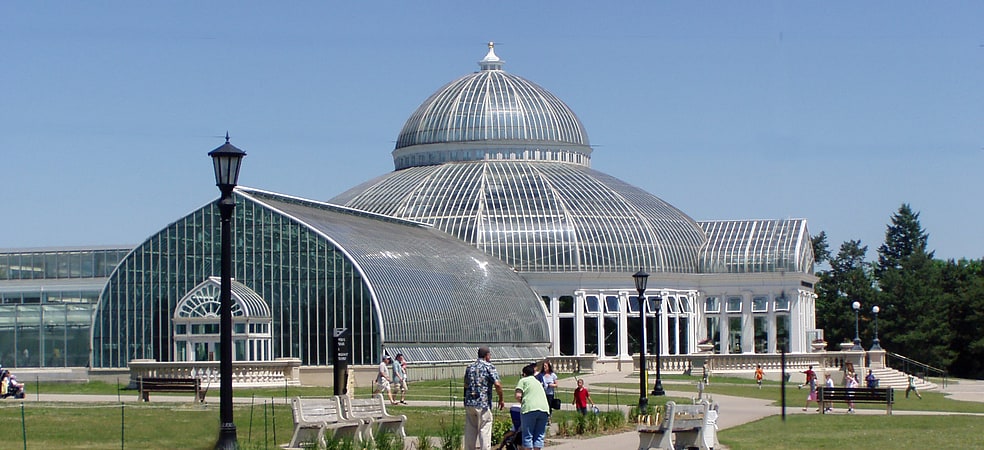
Zoo in Saint Paul, Minnesota. The Como Park Zoo and Marjorie McNeely Conservatory are located in Como Park at 1225 Estabrook Drive, Saint Paul, Minnesota. The park, zoo and conservatory are owned by the City of Saint Paul and are a division of Saint Paul Parks and Recreation. Its attractions include the zoo, the conservatory, an amusement park, a carousel, Lake Como, a golf course, a pool and more. The park receives more than 1.9 million visitors annually. Como Park is a free park and while no admission fee is charged for the zoo or conservatory, voluntary donations of $4 per adult and $2 child are suggested.[10]
Address: 1225 Estabrook Dr, 55103-1022 Saint Paul (Como Park)
Landmark Center
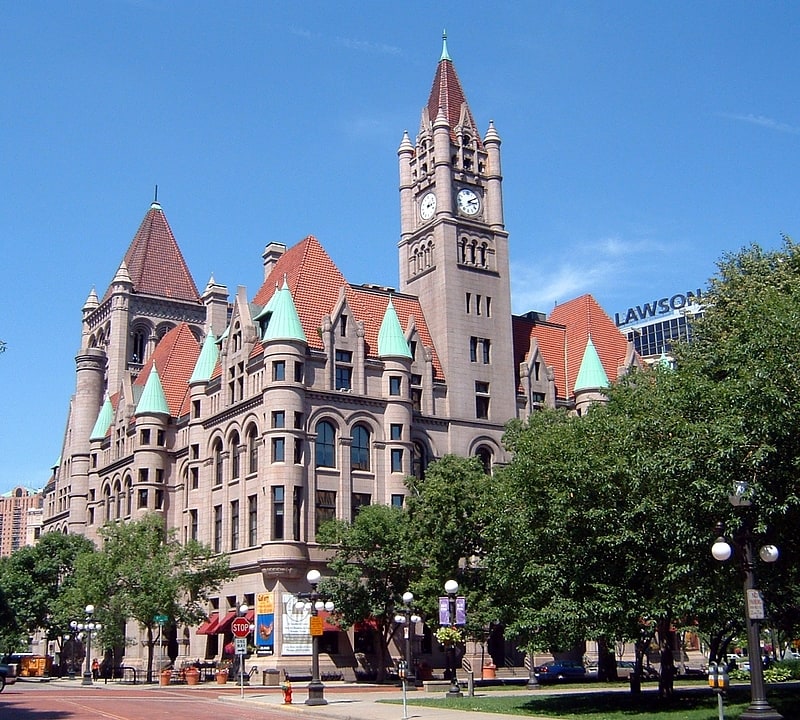
Historical landmark in Saint Paul, Minnesota. St. Paul's historic Landmark Center, completed in 1902, originally served as the United States Post Office, Courthouse, and Custom House for the state of Minnesota. It was designed by Willoughby J. Edbrooke, who served as Supervising Architect of the U.S. Treasury Department in 1891–92. Edbrooke designed a body of public architecture, much of which, like this structure, was completed after his 1896 death. Landmark Center stands at 75 West Fifth Street in Rice Park and is now an arts and culture center.
The exterior is pink granite ashlar with a hipped red tile roof, steeply pitched to shed snow and adorned by numerous turrets, gables and dormers with steeply peaked roofs; cylindrical corner towers with conical turrets occupy almost every change of projection. There are two massive towers, one of which houses a clock. The exterior is almost devoid of carved detail. The interior features a five-story courtyard with skylight and rooms with 20-foot ceilings, appointed with marble and carved mahogany and oak finishes. Its Romanesque Revival architecture is similar to Edbrooke's Old Post Office Building in Washington D.C.
John Dillinger's girlfriend Evelyn Frechette, Alvin "Creepy" Karpis, "Doc" Barker and other members of the Barker-Karpis gang were tried in the building when it served as a federal courthouse.
Judges Walter Henry Sanborn and John B. Sanborn Jr. kept their chambers here while serving on the Eighth Circuit Court of Appeals. U.S. Supreme Court Justice Harry Blackmun worked in the building as a law clerk to the younger Sanborn in 1932–33.
In the 1970s, a citizens' group saved the building from demolition and restored it to its previous grandeur. It was placed on the National Register of Historic Places and reopened to the public as Landmark Center in 1978.
After its comprehensive 1972–78 renovation, the center became home to many prominent Twin Cities arts organizations, now including:
- American Association of Woodturners and the AAW Gallery of Wood Art
- Ramsey County Historical Society Gallery and Research Center – changing exhibits and research area for local history topics
- The Schubert Club Museum of musical instruments
- Landmark Gallery – permanent and temporary exhibits from its local history collection
- "Uncle Sam Worked Here" – a permanent interactive exhibit opened in 2007 about activities in Landmark Center over its history
- Exhibition space for music, dance, theater, and public forums.
For a time the high school St. Paul Conservatory for Performing Artists also held classes on the fifth floor. It has since moved to 16 West 5th Street. The fifth floor now houses the offices of the American Composers Forum.
Owned by Ramsey County, Landmark Center is managed by Minnesota Landmarks, a not-for-profit organization. Landmark Center also houses Anita's Cafe, Landmarket Gift Shop, and five galleries.[11]
Address: 75 5th St W, 55102-1431 Saint Paul
Lake Phalen
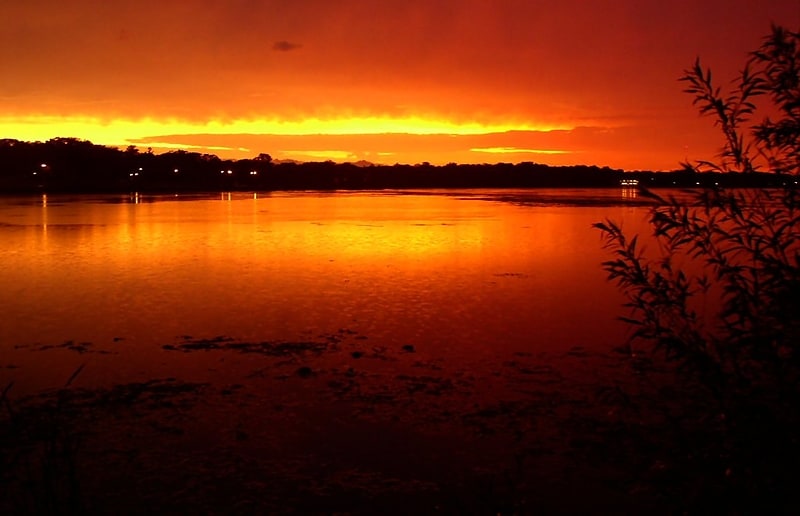
Lake in Minnesota. Lake Phalen is an urban lake located in Saint Paul, Minnesota and in its suburb of Maplewood. It is one of the largest lakes in Saint Paul and is the centerpiece of the Phalen Regional Park System. The lake drains into the Mississippi River after traveling through Phalen Creek. The lake and surrounding 494-acre park receive around 500,000 visitors each year.[12]
Address: 1400 Phalen Drive, Saint Paul
Wabasha Street Caves
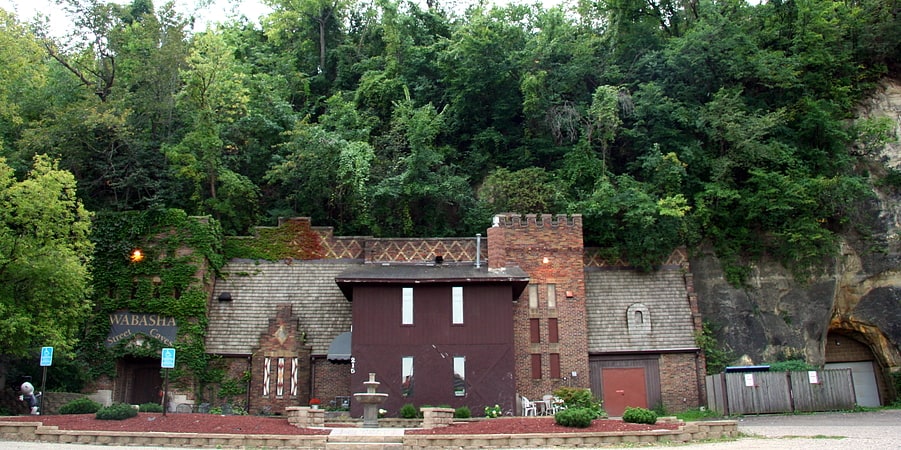
Speakeasy. The Wabasha Street Caves is an event hall built into the sandstone caves located on the south shore of the Mississippi River in downtown Saint Paul, Minnesota. The caves have been home to mobsters, speakeasies, and for the past 30 years have hosted Swing Night every Thursday night with professional live Big Bands and vocalists, playing music of the old Tommy Dorsey, Glenn Miller, Count Basie, Duke Ellington Big Bands. Dances are open to the public and draw crowds in the hundreds. The Wabasha Street Caves also provide historical tours and Murder Mystery Tours in these sandstone caves in Saint Paul, Minnesota near the Mississippi River. Moonlight Serenaders Big Band[13]
Address: 215 Wabasha St S, 55107-1805 Saint Paul (West Side)
Minnesota State Capitol

State government office in Saint Paul, Minnesota. The Minnesota State Capitol is the seat of government for the U.S. state of Minnesota, in its capital city of Saint Paul. It houses the Minnesota Senate, Minnesota House of Representatives, the office of the Attorney General and the office of the Governor. The building also includes a chamber for the Minnesota Supreme Court, although court activities usually take place in the neighboring Minnesota Judicial Center.
There have been three State Capitol buildings. The present building was designed by architect Cass Gilbert and completed in 1905. Its Beaux-Arts/American Renaissance design was influenced by the 1893 World's Columbian Exposition in Chicago, and by McKim, Mead & White's Rhode Island State House. From 2013 to 2017 the building underwent an extensive restoration. This included replacing existing infrastructure; adding new mechanical systems; replacing or repairing tens of thousands of pieces of marble on the exterior; cleaning historic paintings, murals, and sculptures; and adding safety and accessibility features.
The building is set in a landscaped campus with the Capitol Mall on its south front, Leif Erikson Park on its west, and Judicial Plaza to its east. Various monuments and memorials are located in these green spaces.[14]
Address: 75 Rev Dr Martin Luther King Jr Boulevard., 55155 St Paul
Minnesota History Center
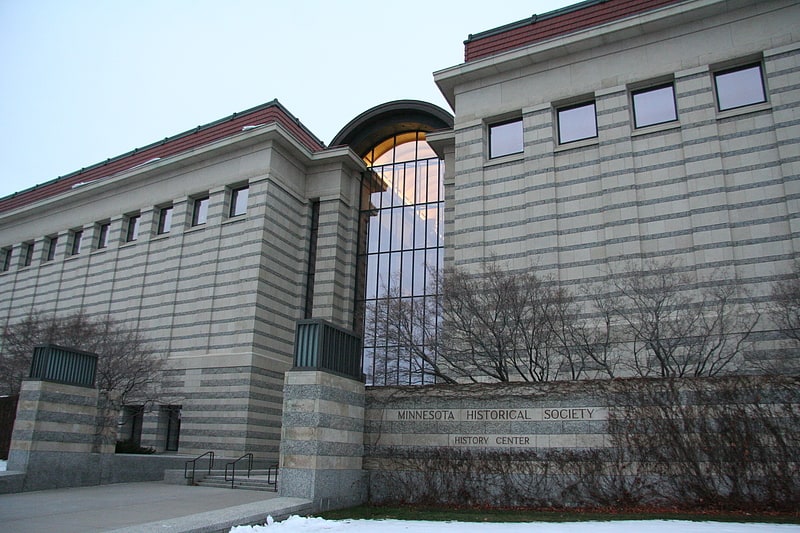
Museum in Saint Paul, Minnesota. The Minnesota History Center is a museum and library that serves as the headquarters of the Minnesota Historical Society. It is near downtown Saint Paul, Minnesota, and is considered one of Minnesota's finest public buildings.
The History Center is on Kellogg Boulevard, between the Mississippi River and the Minnesota State Capitol. Before this building was built in 1992, the Minnesota Historical Society (MNHS) occupied what is now the Minnesota Judicial Center, originally built for the Society in 1917. Before that, MNHS was housed in the basement of the State Capitol.
The Center hosts concerts, dance performances, lectures, conferences, meetings, dinners, political campaign events, memorial services, receptions, parties, and weddings; as many as 75,000 schoolchildren visit the History Center every year.[15]
Address: 345 W Kellogg Blvd, 55102 St Paul
High Bridge
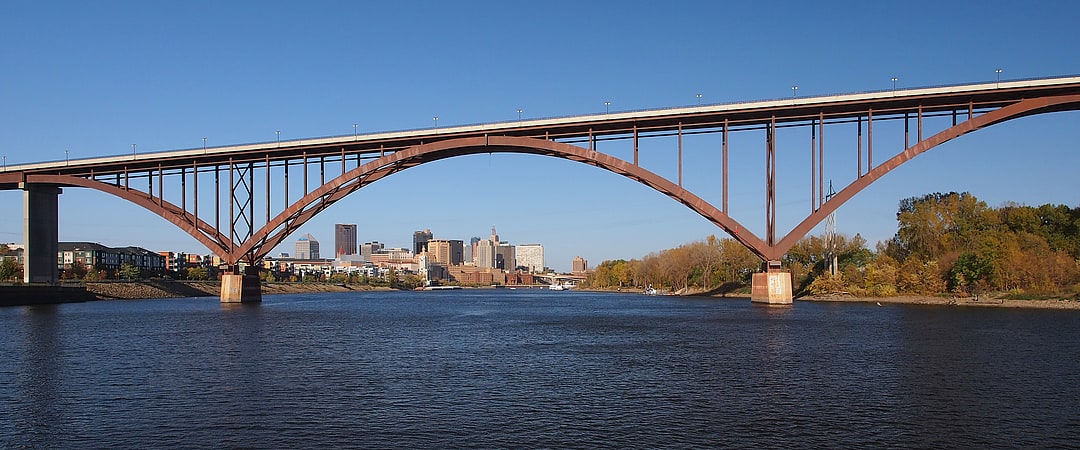
Arch bridge in Saint Paul, Minnesota. The Smith Avenue High Bridge or the High Bridge is an inverted arch bridge that carries Minnesota State Highway 149 and Smith Avenue over the Mississippi River in Saint Paul, Minnesota, United States. It was built and opened in 1987 at a cost of $20 million. The bridge carries two lanes of street traffic over the river and is the highest bridge in St. Paul, with a deck height of 160 ft and a clearance below of 149 ft.
The current bridge replaced a 2,770-foot-long (840 m) iron Warren deck truss bridge constructed in 1889. In 1904 the original bridge was partially destroyed by a tornado or severe storm and the southernmost five spans had to be rebuilt. With modest alterations it served for nearly a century, but in 1977 an inspection found irreparable structural deficiencies. The Minnesota Department of Transportation enacted a weight restriction on the bridge until it was closed in 1984 and demolished in 1985. The ornamental ironwork on the replacement was built using iron from the old bridge. The first bridge had been listed on the National Register of Historic Places in 1981 and was delisted in 1988.
In February 2008, City Pages, a weekly publication in the Twin Cities, published a feature about the long history of suicide at the bridge. The article included testimony of a survivor who leapt from the bridge.
The bridge closed September 2017 for a redecking project. It reopened to traffic the afternoon of November 21, 2018.[16]
Address: Smith Avenue S, 55102 Saint Paul (West Side)
Turf Club
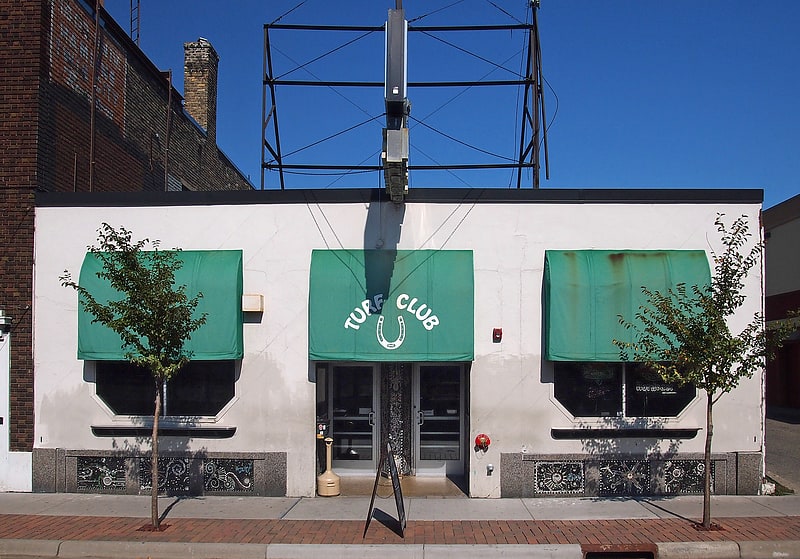
Bar in Saint Paul, Minnesota. The Turf Club is a bar, restaurant and music venue in Saint Paul, Minnesota, United States. Originally a dance hall in the 1940s, the Turf Club has since the 1990s been popular with Twin Cities bands, a sharp contrast to previous years when most local bands only played Minneapolis venues. The club has also become an important venue for national and international touring acts. Japanese indie-rock band Shonen Knife played its 1,000th show at the Turf Club.
The Turf Club was sold to the owners of First Avenue in late 2013. The venue has a capacity of about 350. The club's basement hosts a smaller bar and performance space, the Clown Lounge, which is used for jazz gigs. The Turf Club is located on the north side of University Avenue near Snelling Avenue and across the street from the Snelling Avenue light rail station on the Green Line. In 2014, the club received a substantial remodel, including an upgraded sound system and the return of a mural featuring five racehorses which had been forgotten, hidden behind curtains, for decades.
The building was closed for more than a year in 2020-2021 due to the COVID-19 pandemic, and also incurred fire and water damage during the civil unrest of the George Floyd protests in 2020, requiring months of repair. The Turf Club reopened for concerts in July 2021.[17]
Address: 1601 University Ave W, 55104-3820 St Paul
Ordway Center for the Performing Arts
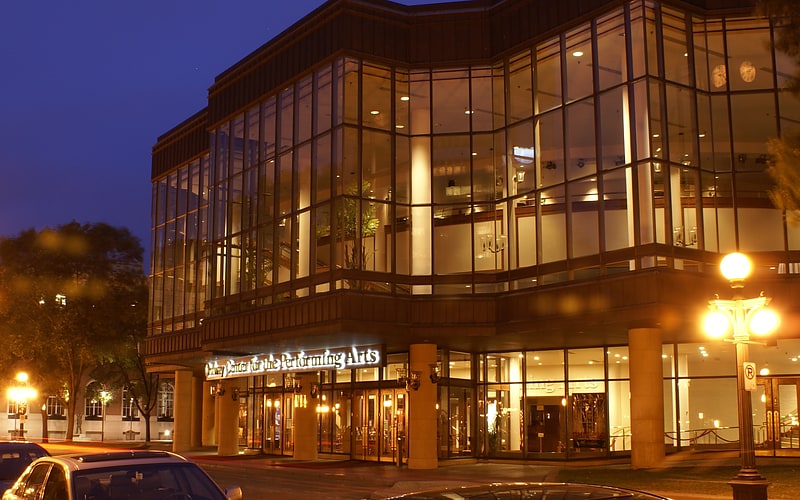
Performing arts theater in Saint Paul, Minnesota. The Ordway Center for the Performing Arts is located in downtown Saint Paul, Minnesota and hosts a variety of performing arts, such as touring Broadway musicals, orchestra, opera, and cultural performers, as well as produces local musicals. It serves as a home to several local arts organizations, including the Minnesota Opera, The Saint Paul Chamber Orchestra, and The Schubert Club. Christopher Harrington is currently the President and CEO. Rod Kaats is the Producing Artistic Director.[18]
Address: Saint Paul, 345 Washington Street
Watergate Marina
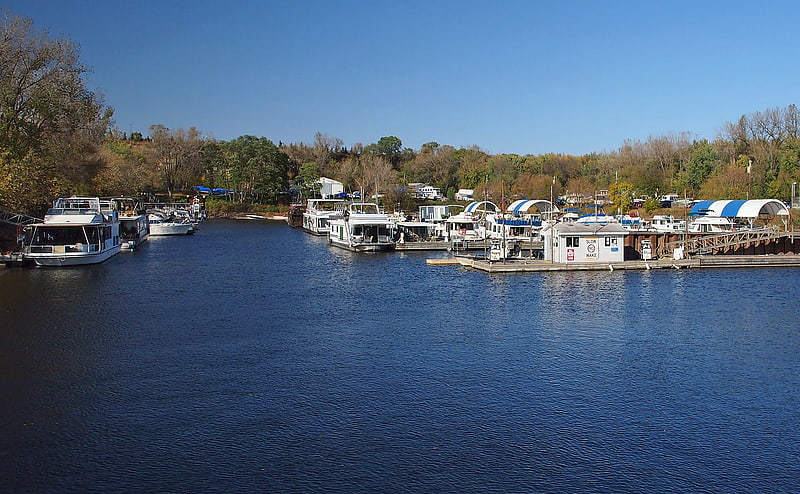
Marina in Saint Paul, Minnesota. Watergate Marina is located on the north bank of the Mississippi River in Saint Paul, Minnesota, United States, upriver from the city's downtown area. Owned by the City of Saint Paul and operated via lease, the privately run, full-service marina has capacity for 160 ships and it charges fees for boat launches.[19]
Assumption Catholic Church
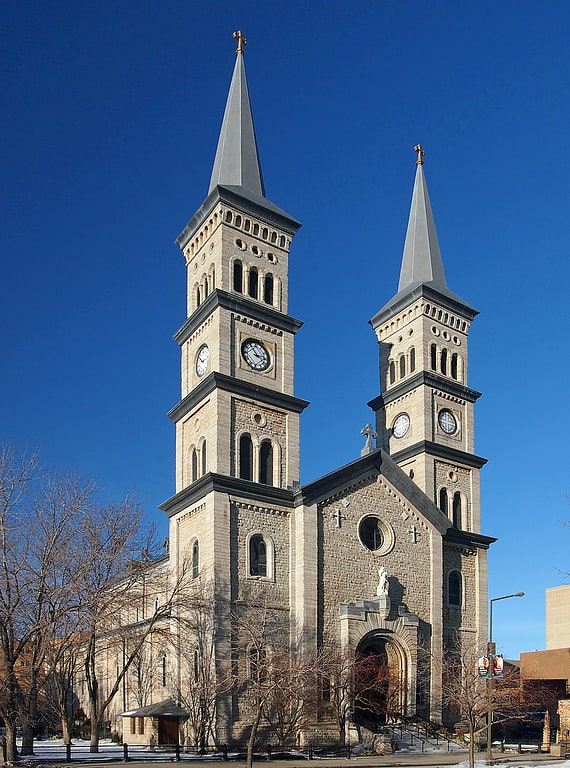
Building in Saint Paul, Minnesota. The Church of the Assumption Catholic Church was dedicated in 1874 and is the oldest existing church in Saint Paul. It is located at 51 West Seventh Street, in downtown Saint Paul. The building is listed on the National Register of Historic Places.
The parish was founded in 1856 by Bishop Joseph Crétin. At that time, immigrants from Germany were arriving, and the single Catholic parish in St. Paul mainly served French and Irish settlers, with services in Latin and sermons in their own languages. The first building was a plain stone structure with a wooden steeple on West Ninth Street. The founding pastor was Father George Keller. After Fr. Keller was transferred to Faribault, Minnesota in 1858, staffing of the parish was met by priests and brothers from St. John's Abbey (Order of St. Benedict) in Collegeville, Minnesota.
By 1869 the parish had outgrown the small chapel and a new building was urgently needed. The church's construction was ordered by then-Archbishop John Ireland, who wanted the city's growing Catholic German immigrant population to have a parish of their own. It was built in a plain Romanesque style of Lake Superior limestone by German Catholics, and is said to have been modeled after the Ludwigskirche in Munich. The architect, Joseph Reidel, was a court architect for the Wittelsbach family in Bavaria, Germany. It was built, according to the plans of the Bavarian Joseph Reidel, by the Germans in 1869-1874 in a neo-Romanesque, stone-washed style of Lake Superior.
The interior design of the church has remained substantially unchanged since the late 19th century. The statue of the Blessed Virgin Mary in the high altar came from the first church. There are shrines to Thérèse of Lisieux and Maria-Hilf; altars for the Blessed Mother and St. John the Baptist, St. Joseph, and St. Lawrence; tapestries of the Good Samaritan and the Sts. Peter and Clemens Society; and other works of art.
As the parish grew, five daughter churches were spun off: Sacred Heart, St. Francis de Sales, St. Matthew's, Church of St. Agnes and Church of St. Bernard.[20]
Address: 51 7th St W, 55102-1117 St Paul
St. Columba Church
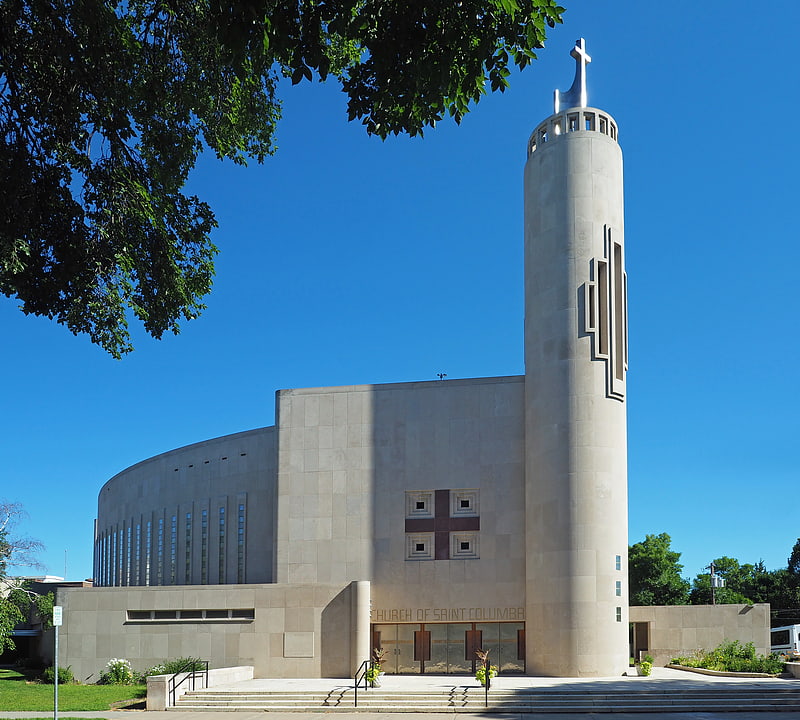
The Church of St. Columba is a Roman Catholic church in Saint Paul, Minnesota, United States. The parish was formed in the Hamline-Midway neighborhood in 1915. After the mid-twentieth century baby boom, the church was expanding and needed a new building. Then-pastor Michael Casey contracted with architect Barry Byrne to design and construct the building. Byrne was based in Chicago and his formal schooling ended in the Ninth Grade. Byrne worked under Frank Lloyd Wright and was involved with the Prairie School of architecture before later turned towards Expressionist architecture. Byrne designed the building later in his career.
The 1949 church is very similar in design to St. Francis Xavier Church in Kansas City, Missouri, that was also designed by Byrne. The pastor Michael Casey had the bell tower built to look like an Irish round tower. The interior of the church is built from two overlapping circles. This creates an elliptical interior and an overhead profile that resembles a fish. The fish is one of the earliest symbols of Christianity and the construction of the shape of the church was undoubtedly intentional. The amount of light available on the inside of the building is worth mentioning. There are more than 24 slit like clerestory windows that let natural light in. The interior lightness contrasts with the heavy concrete exterior. The interior of the church features an under lit cove close to the ceiling. Twin Cities architecture critic Larry Millett views the altar as being small for the large interior of the building. Vincent Michael also believes that the altar is undersized compared to the size of the nave.
Unlike St. Francis Xavier the entrance doors are made of metal instead of polished glass. Michael Vincent believes it still leaves the impression of emptiness underneath the bell tower. To create the internal shape the external walls are curved. They are constructed of limestone. There is a large amount of concrete and has been described as a "tour de force" of concrete. Several elements of the church are viewed as unique due to their combination. Millett sees the slots in the bell tower, the granite crosses embedded in the exterior walls and the metal on the entrance doors as a special grouping.
Millett describes the building as a "high point in modern church architecture in the Twin Cities" and notes it as being removed from many religious and architectural norms. Other critiques note it as having shapes and orders that defy orthodox expectations.[21]
Crosby Farm
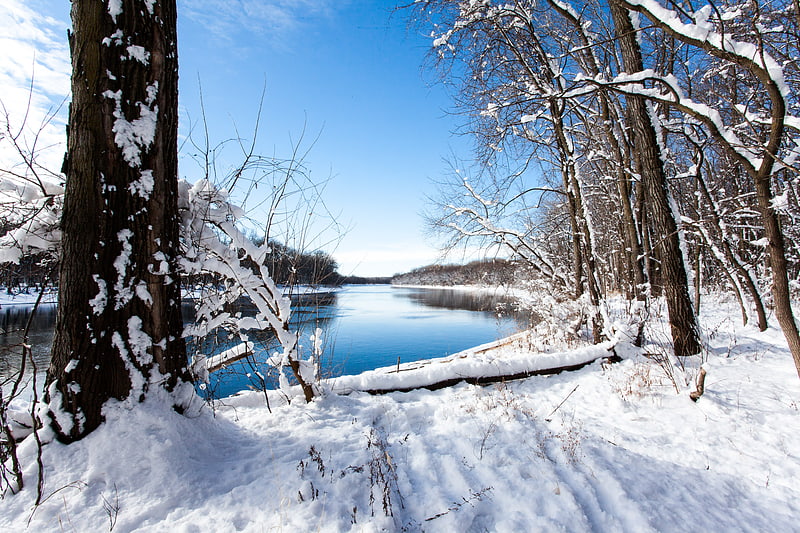
Crosby Farm is a regional park in Saint Paul, Minnesota, United States, that is located in the floodplain forests along the Mississippi River. It is named after a historic farmstead owned by Thomas Crosby from 1858 to 1886. Crosby Farm Regional Park is maintained by the City of Saint Paul and is within the Mississippi National River and Recreation Area.[22]
Address: 2595 Crosby Farm Road, Saint Paul
Christ Lutheran
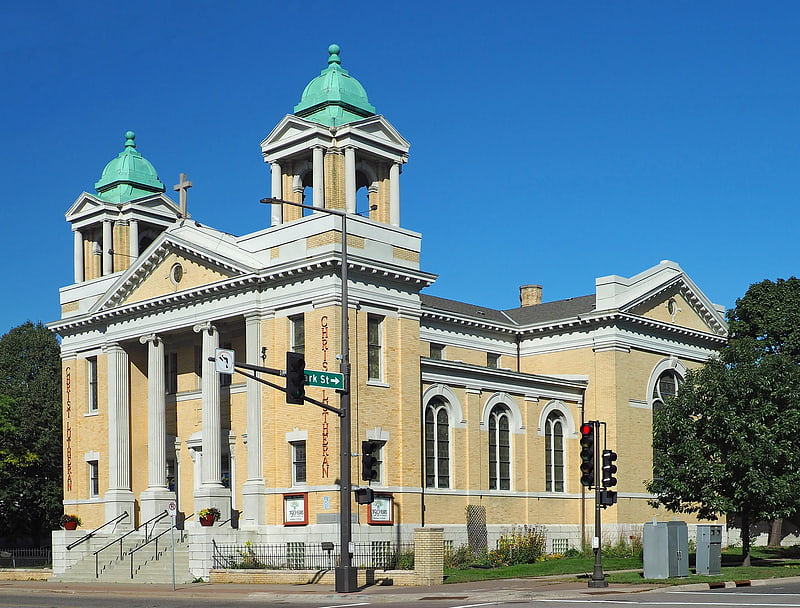
Christ Lutheran Church on Capitol Hill is a congregation of the Evangelical Lutheran Church in America in the Thomas-Dale neighborhood of Saint Paul, Minnesota, United States.
The brick church, built from 1909 to 1915, is atypically designed in Beaux-Arts style by Buechner & Orth to harmonize with the nearby Minnesota State Capitol. It is listed on the National Register of Historic Places.
The oldest part of the building, the north side, was built in 1909. The main church building, facing University Avenue, was constructed in 1915 of yellow brick.
The building's principal facade is symmetrical and features a Classical pediment supported by Ionic columns and pilasters, flanked by bell towers. An office wing, which currently houses the Saint Paul Area Synod of the ELCA, was constructed in 1962–63.
The congregation was formally organized in 1868 as the Scandinavian Lutheran Church Society. Later that year, it was changed from "Society" to "Congregation". In 1869, it was renamed the Norwegian Evangelical Lutheran Church. Services were initially held in members' homes, in the Ramsey County Courthouse, and in the Zion Evangelical Lutheran Church, a German congregation at East 9th and Rosabel Street.
In 1870, the congregation erected its own building at the southwest corner of L'Orient and Mt. Airy Streets. The sandy soil at that site required regular maintenance to keep the building from sliding down the hill, and in 1875, the structure was moved to 13th and Canada Streets.
In 1904, Rev. S.T. Reque began a 37-year tenure as pastor, and in 1909, the current site at Park Street and University Avenue was purchased. The architect, Buechner & Orth, chose an architectural style compatible with the neighboring Minnesota State Capitol. The basement of the new structure was finished for use as a worship space on Christmas Eve 1911. The upper church was dedicated on December 5, 1915.
A few years later, the congregation's name was changed to "Christ Lutheran Church". In 1962, the congregation added the words "on Capitol Hill" to the name to highlight its proximity to the state's seat of civil government.
Baptized membership peaked in 1944 at 1198 persons. The Pastor from 1939–1952, Rev. Joseph Simonson, served as chaplain of the Minnesota Senate for 10 years before being appointed by President Eisenhower as Ambassador to Ethiopia. This led by a visit from Ethiopian Emperor Haile Selassie to Christ Lutheran Church in June 1954. The emperor presented the congregation with a processional cross identical to one presented to the National Cathedral.
In the 1980s, the church's neighborhood experienced an influx of immigrants and refugees from Southeast Asia and Africa. The congregation responded to these demographic changes by establishing a Southeast Asian Ministry to address the needs of this new population.[23]
Minnesota Woman Suffrage Memorial

Garden in Saint Paul, Minnesota. The Minnesota Woman Suffrage Memorial, located in the grounds of the Minnesota State Capitol in Saint Paul, Minnesota, commemorates 25 women whose achievements were important to the Minnesota Woman Suffrage Association.[24]
Gibbs Museum of Pioneer and Dakotah Life
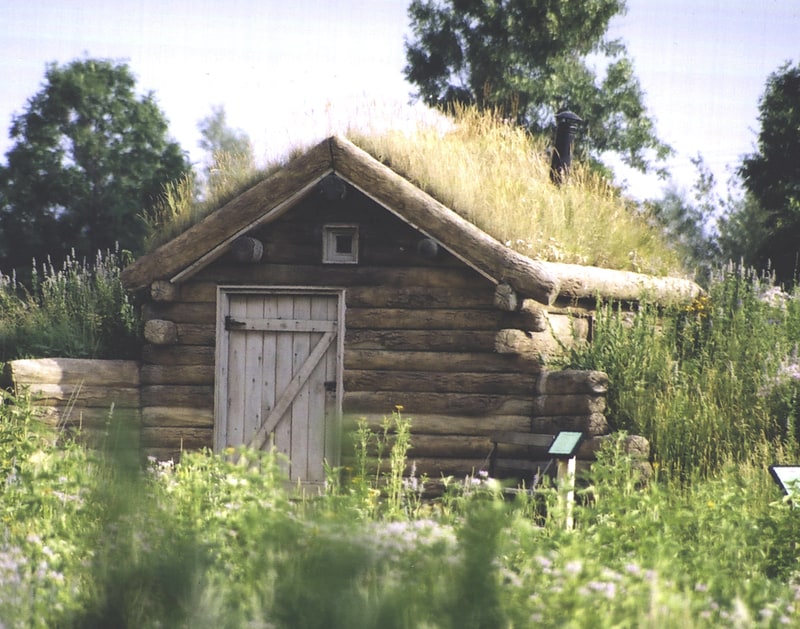
Museum in Falcon Heights. The Gibbs Farm is a museum in Falcon Heights, Minnesota, United States. The site was once the farmstead of Heman Gibbs and Jane DeBow, first built in 1854; the existing farmhouse includes the small, original cabin. The museum seeks to educate visitors on the lives of 19th-century Minnesota pioneers and the Dakota people who lived in southern Minnesota before the arrival of Europeans.
In 1974 the farm was listed on the National Register of Historic Places. The listing consists of the farmhouse and barn, as the other museum structures are not original to the site.[25]
Address: 2097 Larpenteur Ave W, 55113-5313 St Paul
Minnesota Centennial Showboat
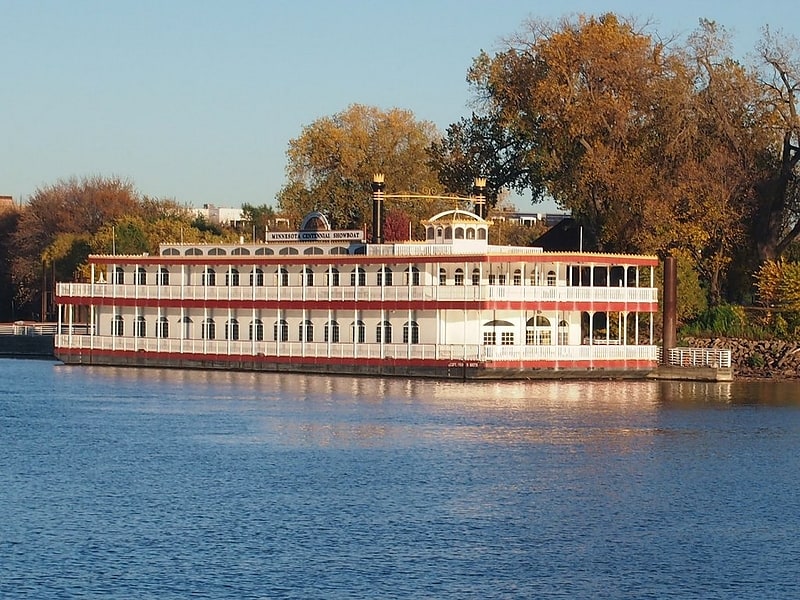
Theatre in Saint Paul, Minnesota. Minnesota Centennial Showboat was a traditional riverboat theatre docked at Harriet Island Regional Park on the banks of the Mississippi River in downtown Saint Paul, Minnesota, United States. The showboat contained an intimate jewelbox theatre that seated 225. The interior was decorated to keep in time with the Victorian Era style commonly associated with showboats. The Minnesota Centennial Showboat was run through a partnership with the University of Minnesota Theatre Department and the Padelford Boat Company. The showboat was a longtime tradition with the University beginning in 1958. The University Theatre utilized the showboat as a learning opportunity for its students to experience professional theatre. The showboat had its final performance in 2016.[26]
Como Lake
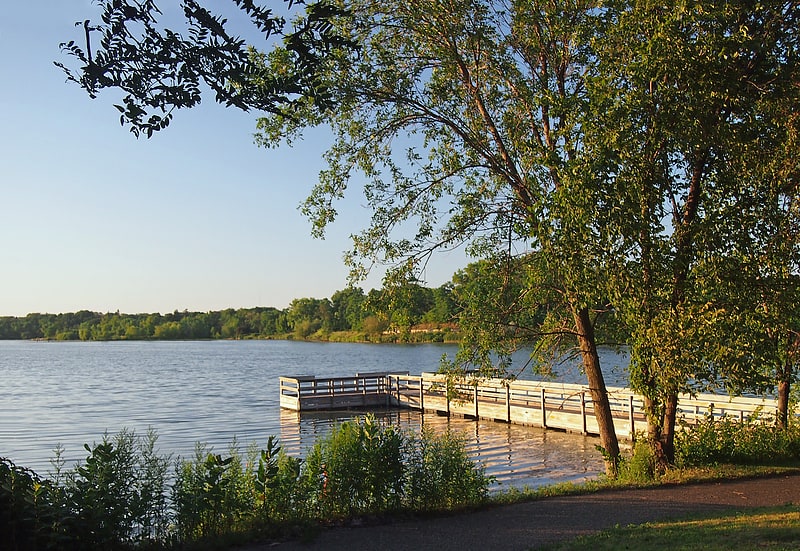
Lake in Minnesota. Como Lake is a 70.5-acre lake up to 15.5 feet deep in St. Paul, Minnesota, United States. It, along with the neighboring Como Park, has been a recreation area for residents of the Twin Cities for more than a century. It was named in 1848 by local farmer Charles Perry. A pavilion sits on the west side of the lake, and plays host to theatrical performances and concerts during the warmer months. The park features a variety of attractions, including the Como Park Zoo and Conservatory and the Como Regional Park Pool.[27]
Address: 1360 Lexington Pkwy N, 55103 Saint Paul (Como Park)
Mississippi National River and Recreation Area
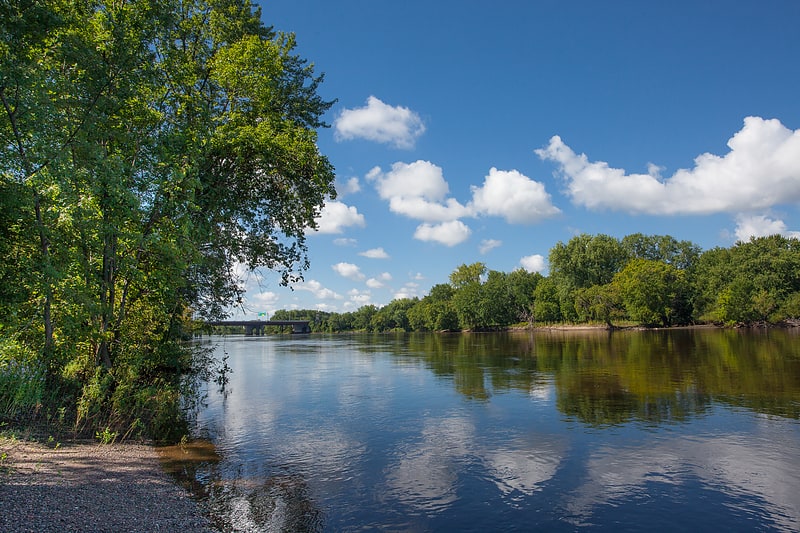
National recreation area in Minnesota. The Mississippi National River and Recreation Area is a 72-mile and 54,000-acre protected corridor along the Mississippi River through the Minneapolis–Saint Paul metro in the U.S. state of Minnesota, from the cities of Dayton and Ramsey, to just downstream of Hastings. This stretch of the upper Mississippi River includes natural, historical, recreational, cultural, scenic, scientific, and economic resources of national significance. This area is the only national park site dedicated exclusively to the Mississippi River. The Mississippi National River and Recreation Area is sometimes abbreviated as MNRRA or MISS, the four letter code assigned to the area by the National Park Service. The Mississippi National River and Recreation Area is classified as one of four national rivers in the United States, and despite its name it is technically not one of the 40 national recreation areas.[28]
Alexander Ramsey House

Museum in Saint Paul, Minnesota. The Alexander Ramsey House is a historic house museum in Saint Paul, Minnesota, United States; the former residence of Alexander Ramsey, who served as the first governor of Minnesota Territory and the second governor of the state of Minnesota. It was listed on the National Register of Historic Places in 1969. It is also a contributing property to the Irvine Park Historic District.
It is located at 265 Exchange Street South in the Irvine Park area, which was one of the first trendy neighborhoods in Minnesota. Designed by noted early Minnesota architect Monroe Sheire, the house is one of the nation's best-preserved Victorian homes, featuring carved walnut woodwork, marble fireplaces, crystal chandeliers, and many original furnishings.
The Ramsey family began building the house in 1868, including innovations like hot water radiators, gas lights and hot and cold running water, and when it was completed in 1872, the total cost of construction was nearly $41,000. To furnish the house, Ramsey's wife Anna filled two boxcars with fashionable and expensive Renaissance-revival furniture from the A.T. Stewart Company Store in New York to bring home to Minnesota.
The Ramseys' daughter Marion married Charles Furness in a lavish wedding in the parlor in 1875.
The 15-room house remained in the Ramsey family until the death of Alexander Ramsey's last surviving granddaughter Anita in 1964. The house and its contents were left to the Minnesota Historical Society, which now operates it as a museum with tours offered year-round. They offer special programs such as "A Victorian Christmas at the Ramsey House" in which the house is decorated for the holidays and visitors can discover how the Ramseys would have prepared for and celebrated Christmas. Tours show the dining table set with the family's china and crystal, with a Christmas tree decorated with the family's own ornaments.[29]
Address: 265 Exchange St S, 55102-2445 Saint Paul
Minnesota Transportation Museum
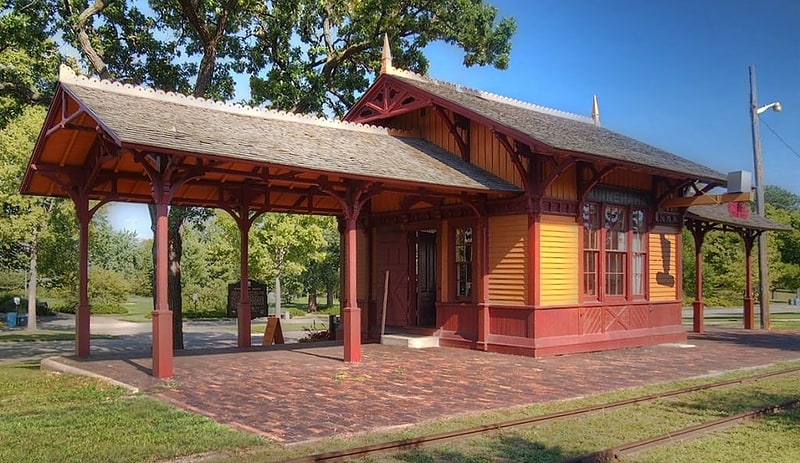
Museum in Saint Paul, Minnesota. The Minnesota Transportation Museum is a transportation museum in Saint Paul, Minnesota, United States.
MTM operates several heritage transportation sites in Minnesota and one in Wisconsin. The museum is actively involved in preserving local railroad, bus and streetcar history.
MTM was formed in 1962 to save a streetcar that had been built and operated by Twin City Rapid Transit (TCRT) in Minneapolis–St. Paul. Many of the museum's early members were formerly part of the Minnesota Railfans Association, which had organized railfan trips from the 1940s to the 1960s.
In 2004–2005, the organization's streetcar operations became the Minnesota Streetcar Museum, with the steamboat Minnehaha, originally built by TCRT in a style similar to its streetcars, becoming a major attraction of the Museum of Lake Minnetonka.[30]
Address: 193 Pennsylvania Ave E, 55130 St Paul (Thomas - Dale)
College of Visual Arts
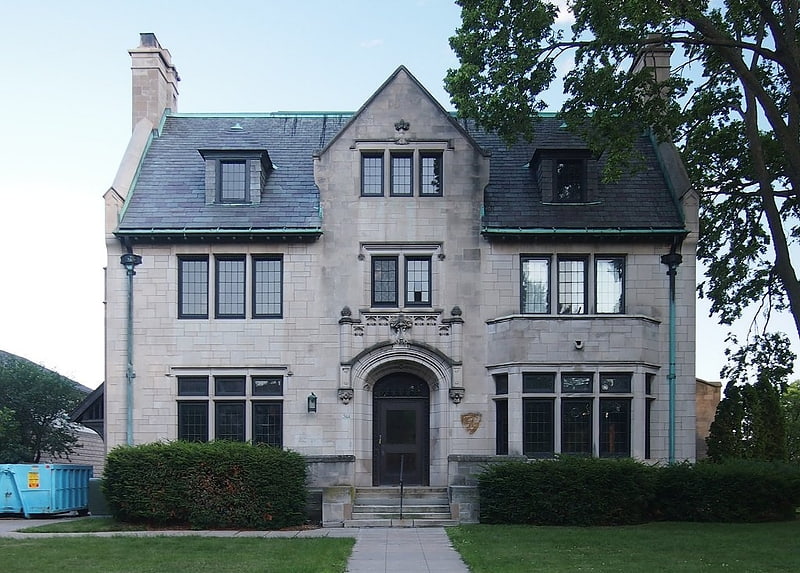
College in Saint Paul, Minnesota. The College of Visual Arts in Saint Paul, Minnesota, United States, was a private, accredited, four-year college of art and design offering a Bachelor of Fine Arts degree in fine arts, graphic design, illustration, and photography. The fine arts degree offered concentrations in drawing, painting, printmaking, and sculpture.
CVA began as one of the first learning environments in the Twin Cities specifically designed to ignite the creativity of artists and designers. CVA was one of a handful of art and design colleges in the U.S. that provided an arts education steeped in the liberal arts. With an enrollment of approximately 200 students and a faculty of 50, CVA offered a low student-teacher ratio. The college was one of only two private art and design colleges in Minnesota. The college announced in January 2013 that its doors would be closing forever effective in June. President Ann Ledy resigned on January 23, 2013, and Dr. Susan Short served as Acting President until the college closed on June 30, 2013.[31]
Indian Mounds Park

Park in Saint Paul, Minnesota. Indian Mounds Regional Park is a public park in Saint Paul, Minnesota, United States, featuring six prehistoric Native American burial mounds overlooking the Mississippi River. The oldest mounds were constructed 1,500–2,000 years ago by people of the Hopewell tradition. Later the Mdewakanton Dakota people interred their dead there as well. At least 31 more mounds were destroyed by development in the late 19th century. They were the tallest Native American mounds in Minnesota and Wisconsin, and comprise one of the northwesternmost Hopewellian sites in North America. Indian Mounds Regional Park is a component of the Mississippi National River and Recreation Area, a unit of the National Park System. The Mounds Group is listed on the National Register of Historic Places. The 2014 nomination document provides a description of the archaeology and the context.[32]
Address: 10 Mounds Blvd., 55106 Saint Paul
Saint Paul City Hall and Ramsey County Courthouse
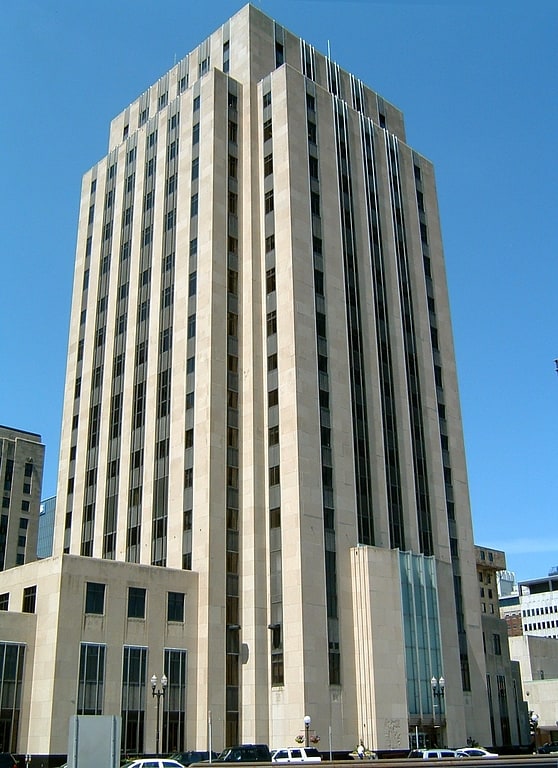
The Saint Paul City Hall and Ramsey County Courthouse, located at 15 Kellogg Boulevard West in Saint Paul, Ramsey County, in the U.S. state of Minnesota is a twenty-story Art Deco skyscraper completed in 1932. Built during the Great Depression era of high unemployment and falling prices, the four million dollar budget for the building was underspent, and the quality of materials and craftsmanship were higher than initially envisioned. The exterior consists of smooth Indiana limestone in the Art Deco style known as "American Perpendicular", designed by Thomas Ellerbe & Company of Saint Paul and Holabird & Root of Chicago and inspired by Finnish architect, Eliel Saarinen. The vertical rows of windows are linked by plain, flat, black spandrels. Above the Fourth Street entrance and flanking the Kellogg Boulevard entrance are relief sculptures carved by Lee Lawrie.
The interior design in the "Zigzag Moderne" style drew its inspiration from the Exposition Internationale des Arts Décoratifs et Industriels Modernes, which promoted soft ornamentation and sensuous curves. In Memorial Hall the white marble floor contrasts with three-story black marble piers leading to a gold-leaf ceiling. At the end of the hall is the 60-ton, 38 feet (11.6 m) white onyx Indian God of Peace by Carl Milles (later renamed Vision of Peace). Other features include woodwork fashioned out of twenty-three different species of wood and uses five different types of imported marble. Murals were painted by John W. Norton while the six bronze elevator doors were made by Albert Stewart.[33]
Address: 15 Kellogg Blvd W, 55102-1635 Saint Paul
Rice Park
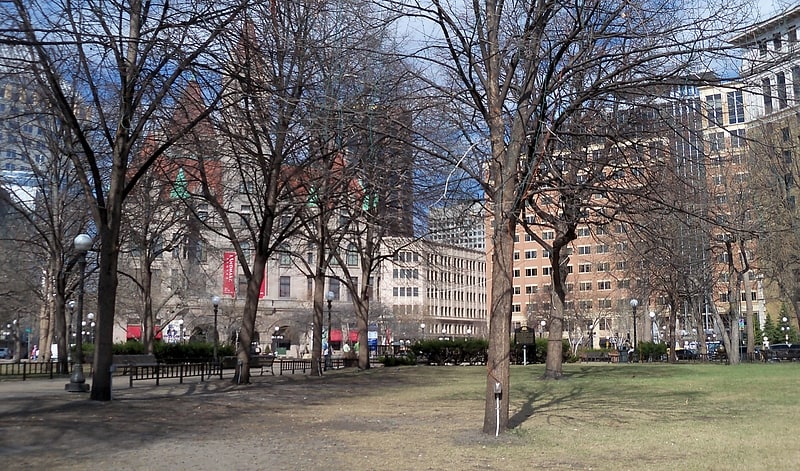
Park in Saint Paul, Minnesota. Rice Park is a public park in downtown Saint Paul, Minnesota, United States.
Features of the park include a fountain, a bandstand, sculptures of characters from the Peanuts cartoons and an ice-rink during the winter months. Rice Park is one of the venues of the Saint Paul Winter Carnival; in selected years, an ice palace is built as part of the festivities.
Rice Park is bordered by the 1902 Landmark Center to the north, the 1910 Saint Paul Hotel to the east, the 1917 George Latimer Central Library to the south, and the Ordway Center for the Performing Arts to the west.[34]
Address: 109 W 4th St, 5th St / Washington St / 4th St / Market St, 55101 Saint Paul
Robert Street Bridge
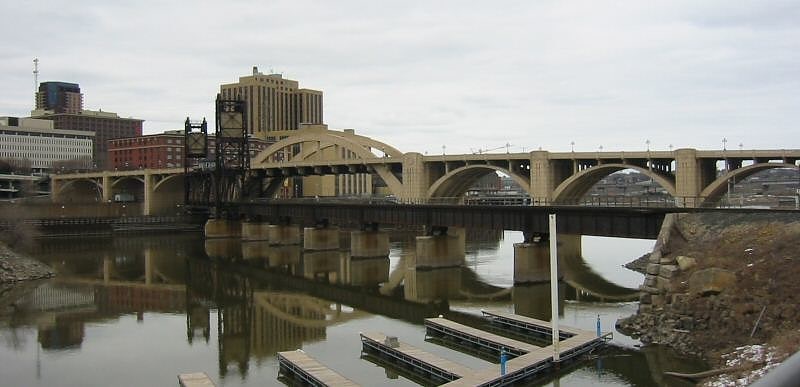
Deck arch bridge in Saint Paul, Minnesota. The Robert Street Bridge is a reinforced concrete multiple-arch bridge that spans the Mississippi River in downtown Saint Paul, Minnesota, United States. The bridge is notable for its complex design that was required to accommodate river traffic, the St. Paul Union Pacific Vertical-lift Rail Bridge crossing underneath it at an angle, and roadways on the downtown side of St. Paul. The bridge is also notable for a monumental reinforced concrete rainbow arch. The rainbow arch not only provides 62 feet of headroom above the river, but also provides a strong aesthetic focus. It was built in 1924–1926 by Fegles Construction Company, Ltd. and designed by Toltz, King & Day. The bridge was added to the National Register of Historic Places in 1989. The bridge as well as Robert Street itself are named after Captain Louis Roberts, a notable French Canadian river boat captain, businessman and early settler of Saint Paul, MN.
The bridge was commissioned in the early 1920s to replace a wrought-iron span, originally built in 1884-1885, that had become obsolete due to increasing traffic. The engineers who designed the bridge had several obstacles to work around. The tracks of the Chicago, St. Paul, Minneapolis and Omaha Railway, St. Paul Union Depot, and the Chicago Great Western Railway mainline were factors. The engineers also had to provide adequate clearance above the river, as defined by the United States War Department at the time. Finally, the bridge had to clear Second Street in downtown St. Paul and work through a busy manufacturing district at the south end. The location of nearly every pier was dictated by these requirements. As a result, the bridge was designed with a combination of barrel-arch and rib-arch flanking spans and a rainbow arch for the central span.
One of the members of the crew building the bridge was Warren Burger, future Chief Justice of the United States.[35]
Address: 1 Robert St S, 55107 Saint Paul (West Side)